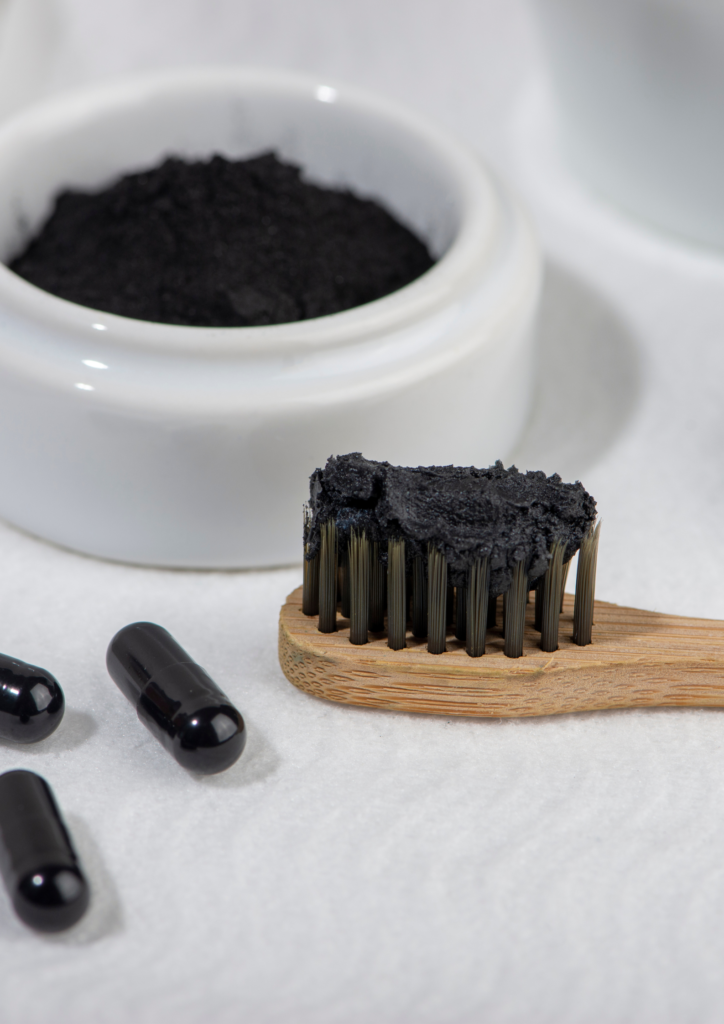Boost Your Gut Health: Guide to Fermented Foods & Drinks
Discover the secrets to a healthier gut through fermented foods and probiotic drinks. Fermentation, a centuries-old preservation method, has transformed our diets for millennia. It not only boosts the flavor and nutritional value of our favorite dishes but also supports a healthy gut microbiome.
At the core of fermentation is a blend of beneficial bacteria and yeasts. They work together to break down complex compounds into simpler, more accessible nutrients. As these probiotic-rich foods and drinks pass through our digestive system, they nourish our gut flora. This promotes better digestion, nutrient absorption, and immune function.
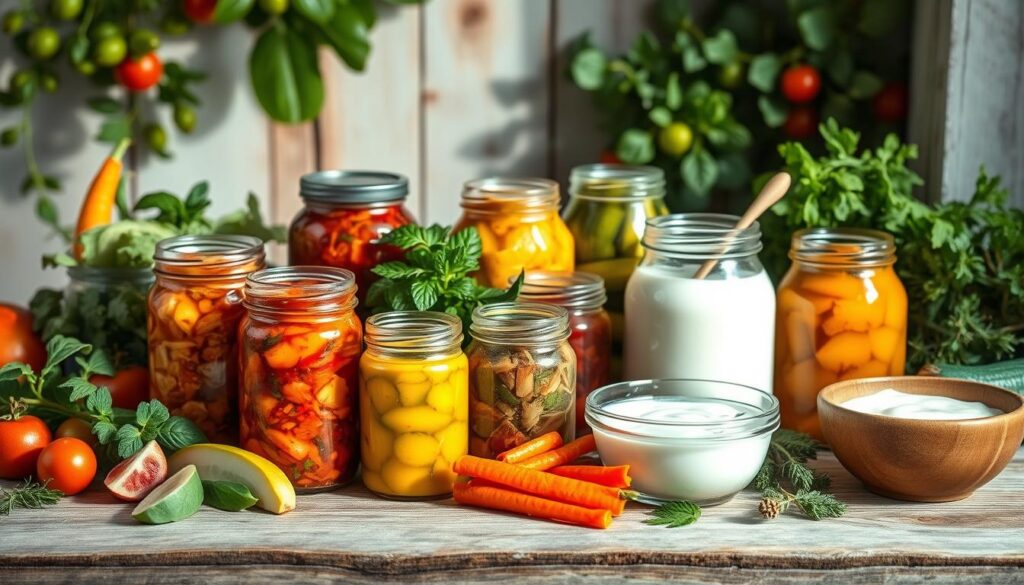
The world of fermented foods and beverages is a treasure trove of gut-healing wonders. From the tangy crunch of sauerkraut to the effervescent delight of kombucha, there’s much to explore. Join us as we delve into the science behind fermentation, its historical significance, and the essential fermented foods that can boost your well-being. Check out this kombucha recipe here.
Get your two free recipes here.
Key Takeaways
- Fermentation is a natural preservation process that transforms foods and drinks, making them probiotic-rich and nutrient-dense.
- Fermented foods have been part of the human diet for thousands of years, with evidence dating back to 7000 BC in China.
- Fermented foods are essential for gut health, providing beneficial bacteria that aid digestion and support the immune system.
- The fermentation process creates complex, tangy flavors that enhance the taste of vegetables, fruits, and dairy products.
- Incorporating fermented foods into your daily diet can offer a wide range of health benefits, from better gut function to improved metabolic and cardiovascular health.
Understanding the Science Behind Fermentation and Gut Health
The gut microbiome, a complex community of microorganisms in our digestive tract, is vital for our health. Fermentation, a natural process, converts sugars into alcohols, carbon dioxide, and organic acids by probiotic bacteria. This process is key to maintaining a healthy gut microbiome.
The Role of Beneficial Bacteria in Fermentation
Fermented foods are rich in probiotics, beneficial microorganisms that support our gut microbiome. These probiotic bacteria, like Lactobacillus and Bifidobacterium, aid digestion, boost the immune system, and enhance digestive wellness.
How Fermentation Enhances Nutrient Availability
The fermentation process transforms dietary fiber into forms more easily absorbed by the body. This makes nutrients more available, contributing to the health benefits of fermented foods.
The Connection Between Fermented Foods and Digestive Health
Research indicates that fermented foods positively impact the gut microbiome, both short and long term. Consuming probiotic-rich foods like yogurt, kimchi, sauerkraut, kombucha, and kefir can reduce inflammation and improve digestive health.
Adding fermented foods to your diet is a simple way to support a healthy gut microbiome. This, in turn, promotes overall digestive and immune system health.
“Six servings a day of fermented foods can lower inflammation and improve gut microbiome diversity.”
| Fermented Food | Probiotic Strains | Health Benefits |
|---|---|---|
| Yogurt (Get your yogurt maker here) | S. thermophilus, L. bulgaricus | Supports gut health, boosts immunity |
| Kimchi (Get your kimchi postbiotic here) | Lactobacillus, Leuconostoc, Weissella | Anti-inflammatory, improves digestion |
| Sauerkraut (Get your free recipe here) | Lactobacillus, Leuconostoc, Pediococcus | Enhances gut microbiome, aids IBS |
| Kombucha | Lactobacillus, Bifidobacterium | Antioxidant, antimicrobial properties |
| Kefir | Lactobacillus, Streptococcus, Leuconostoc | Supports immune function, aids digestion |
Historical Significance of Fermented Foods in Human Diet
Fermented foods have been a cornerstone of human nutrition for nearly 10,000 years. The earliest signs of intentional fermentation were found in Chinese pottery from 7000 BC. This method was primarily used for food preservation, allowing for longer storage of perishables during scarcity.
The creation of cheese around 6500 BC marked a significant milestone. It concentrated nutrients and removed lactose, making it suitable for lactose-intolerant adults. Fermented foods have been pivotal in various cultural cuisines globally, showcasing regional variations and traditional ancient diets.
| Statistic | Data |
|---|---|
| Fermented foods and beverages account for | about one-third of the global human diet |
| Consumers are increasingly interested in | fermented foods and beverages |
| There are thousands of different | fermented foods and beverages due to the various food-microbe combinations |
Fermentation has deeply influenced human history, shaping cultural cuisine and providing vital food preservation techniques. The lasting importance of fermented foods in our diet highlights their universal appeal, nutritional benefits, and the enduring nature of traditional fermentation practices worldwide.
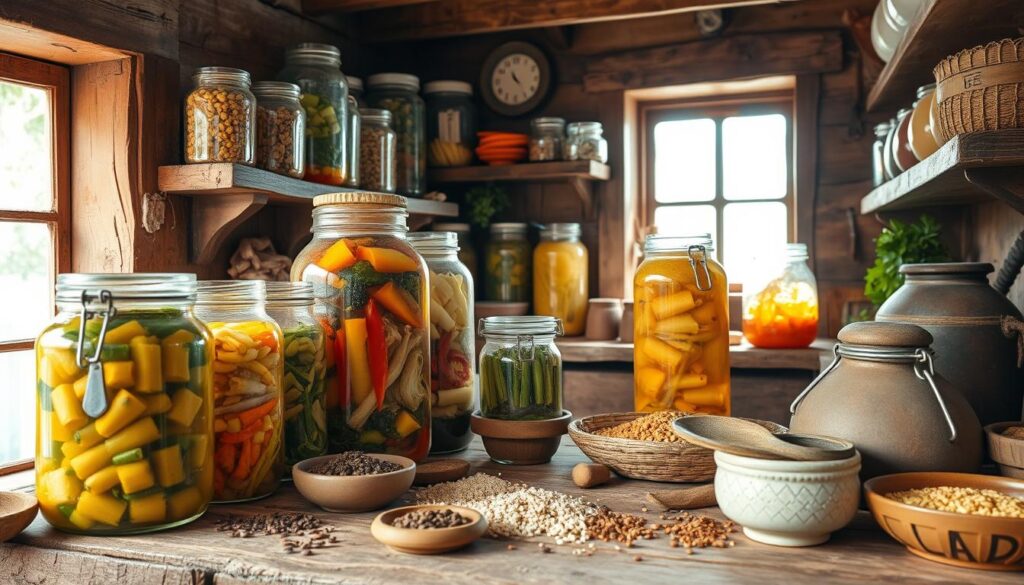
“Fermentation has been used historically to prolong the shelf life of food and enhance its nutritional quality.”
Essential Types of Fermented Foods for Optimal Gut Health
Keeping your gut healthy is vital for your overall wellbeing. Adding a variety of fermented foods to your diet can be transformative. From dairy-based delights to plant-powered options, fermented foods offer numerous gut-nourishing choices. Check out this Kombucha home brewing starter kit here.
Dairy-Based Fermented Products
Fermented dairy products like kefir and plain yogurt are key for gut health. They are rich in probiotics, aiding in lactose breakdown for those with intolerance. Kefir, in particular, is packed with diverse microbes. These may help manage blood sugar, aid in weight loss, and reduce inflammation.
Plant-Based Fermented Foods
Plant-based fermented foods are just as beneficial. Kimchi and sauerkraut are fermented vegetables rich in probiotics, prebiotics, and fiber. They support a healthy digestive system. Regular kimchi consumption may lower cholesterol, improve blood sugar, and reduce inflammation.
Traditional Fermented Beverages
Kombucha, a fizzy fermented tea, and beet kvass, a traditional Slavic drink, are probiotic-rich fermented drinks. Despite containing residual sugar, they offer health benefits like antioxidants and a diverse gut microbiome.
Adding a variety of these fermented foods and drinks to your diet can be both delicious and beneficial for your gut health and overall wellbeing.
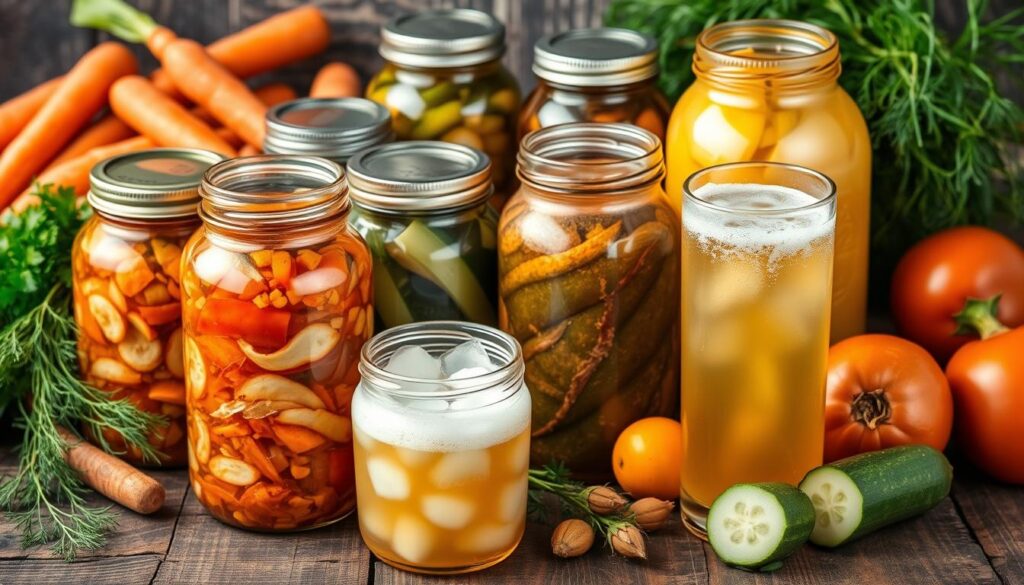
| Fermented Food | Key Benefits |
|---|---|
| Kefir | Potential benefits for blood sugar control, weight loss, and inflammation reduction |
| Yogurt (Get your yogurt maker here) | Improved gut health, better heart health, and reduced risk of certain cancers and type 2 diabetes |
| Kimchi (Get your kimchi postbiotic here) | Lowered blood lipid levels, healthy weight support, reduced blood pressure, and decreased inflammation |
| Sauerkraut (Get your free recipe here) | Reduced symptoms of irritable bowel syndrome and potential benefits in lowering cholesterol levels |
| Kombucha | Antioxidant properties and potential for promoting a more diverse gut microbiome |
The Power of Probiotic-Rich Foods and Their Benefits
Gut health is fundamental to overall wellbeing. Probiotic-rich fermented foods are key in supporting digestive wellness. These foods are packed with live beneficial bacteria. They positively impact the gut microbiome, enhancing digestion, nutrient absorption, and immune system strength.
Since the early 1900s, fermented foods have been prized for their health benefits. Researchers suggest adding them to dietary guidelines. They offer direct nutritional value and support for gut microbes. Additionally, microbes in these foods can survive stomach acid and interact with the gut microbiome.
Yogurt and kefir lead in demand and sales among fermented foods. Cottage cheese, quark, and buttermilk are also valued for their high protein and probiotic benefits. Studies indicate that aged cheeses like cheddar retain probiotics well. Cultured buttermilk has a similar probiotic effect as yogurt and kefir.
| Fermented Food | Probiotic Benefits |
|---|---|
| Sauerkraut and Kimchi (Get your free recipe here) | Traditional fermented vegetables with active cultures and acetic acid, providing probiotic benefits when consumed soon after fermentation. |
| Natto | Probiotic-rich food made using spore-forming bacteria that can withstand heat and salt. |
| Tempeh | A paraprobiotic food that is inactivated by cooking but still stimulates the immune system and increases shelf life. |
Adding a variety of probiotic-rich fermented foods to your diet can greatly benefit gut health, probiotic bacteria, digestive wellness, and the immune system. For instance, kefir, with up to 61 strains of yeast and bacteria, is more potent than yogurt in nourishing the gut microbiome.
“Fermented foods have been shown to reduce insulin resistance, lower cholesterol, and even aid in weight management when consumed regularly.”
By embracing probiotic-rich fermented foods, you can unlock a healthier, more vibrant you. Discover the secrets of gut health and unlock your body’s potential to thrive.
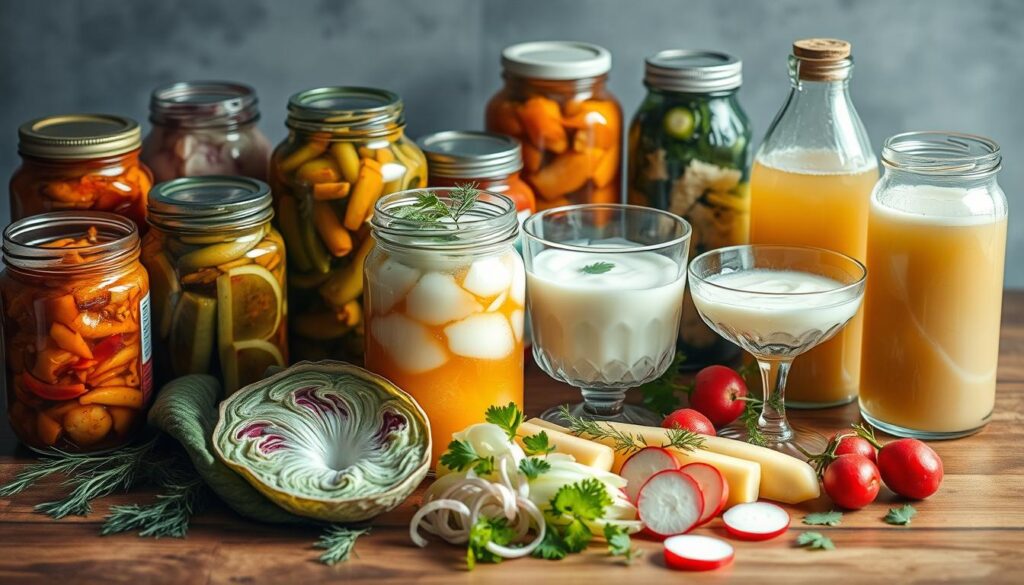
Traditional Preservation Methods and Modern Fermentation Techniques
Preserving food has been crucial throughout human history. Traditional methods like canning, pickling, and lacto-fermentation have proven their worth. Canning and pickling use heat or acids to stop microbial growth. Fermentation, however, relies on beneficial bacteria and yeasts to break down sugars and carbs. This process creates a tangy, probiotic-rich product.
Traditional Preservation Methods
Pickling involves soaking vegetables or fruits in a brine or vinegar solution. This method can extend shelf life up to 3 months when refrigerated. On the other hand, lacto-fermentation uses lactic acid bacteria to preserve foods. It often takes a week or more on the countertop before moving to the fridge for further development.
Modern Fermentation Techniques
In the last decade, home fermentation has gained immense popularity. Enthusiasts are now exploring a variety of fermented foods and drinks. Modern techniques focus on controlling environment, temperature, and specific bacterial cultures. This ensures optimal flavor and food safety. Check out this fermentation and pickling guide plus recipes here.
Safety Guidelines for Home Fermentation
- Use clean, sterilized equipment to prevent contamination
- Monitor pH levels and fermentation progress to maintain a safe environment
- Watch for signs of spoilage, such as off-odors or visible mold, and discard any questionable batches
- Refrigerate fermented foods after the initial fermentation period to slow down the process and extend shelf life
Understanding traditional preservation methods and modern fermentation techniques opens a world of flavors. Home cooks can create probiotic-rich foods that nourish the gut and support health.
Kimchi and Sauerkraut: Top Choices for Digestive Wellness
In the world of fermented foods, kimchi and sauerkraut are at the forefront for gut health. These probiotic-rich, fiber-packed fermented vegetables bring numerous benefits for digestive wellness.
The fermentation process transforms the fiber into beneficial acids. This transformation creates the unique flavors and health benefits of these foods. Kimchi and sauerkraut are packed with lactic acid bacteria. They not only provide probiotics but also act as prebiotics, feeding the beneficial microbes in your gut.
Recent studies have shown the benefits of fermented foods in the diet. A 2021 study by Stanford University found that eating six servings of fermented foods daily for 10 weeks improved microbiome diversity. It also lowered inflammatory markers linked to stress, Type 2 diabetes, and rheumatoid arthritis. Find a fermentation kit here. The perfect way to start making sauerkraut and kimchi.
| Fermented Food | Key Benefits |
|---|---|
| Kimchi (Get your kimchi postbiotic here) | Rich in Lactobacilli species Antioxidant, cholesterol-lowering, and immune-enhancing properties Anti-obesity effects |
| Sauerkraut (Get your free recipe here) | Contains vitamins C and K Provides beneficial bacterial species when unpasteurized May be unsuitable for those with IBS due to high levels of fermentable carbohydrates |
Both kimchi and sauerkraut can be easily added to your diet. You can make them at home or buy them from the store. Embrace these fermented foods to support your gut health and overall well-being.
“Regularly consuming a variety of fermented foods has been found to improve gut health and does not necessarily require a focus on probiotic-rich terminology.”
Getting Started with Home Fermentation
Explore the realm of fermentation and discover its benefits for gut health and flavor. With key equipment and supplies, you can craft your own probiotic-rich fermented foods and beverages at home. Find your equipment here.
Essential Equipment and Supplies
For successful home fermentation, you’ll need:
- Glass jars or containers with an airlock lid to maintain an anaerobic environment
- Weights to keep your vegetables or fruits submerged in the brine. Get your 10-pack fermentation weights here.
- High-quality salt like pink Himalayan or sea salt
- Fresh, organic produce (vegetables, fruits, or dairy)
- A food scale to measure ingredients accurately. Get your High Capacity food scale here.
- A sharp knife and mixing bowls for preparation. Get Victorinox knives here.
Basic Fermentation Recipes for Beginners
Embark on your fermentation journey with these simple recipes:
- Sauerkraut: Shred cabbage, mix with salt, and let it ferment for 4-6 weeks. (Get your free recipe here)
- Kimchi: Combine napa cabbage, radish, garlic, ginger, and Korean red pepper flakes, then ferment for 2-4 weeks.
- Kombucha: Brew sweetened black or green tea, add a SCOBY (symbiotic culture of bacteria and yeast), and let it ferment for 1-4 weeks. Find a complete recipe here.
When using fermented foods in cooking, add them as a topping or mix in at the end. This helps preserve their probiotic benefits.
“Fermentation is the metabolic process that converts sugar to acids, gases, or alcohol. It’s the foundation for foods and drinks we love, like wine, cheese, chocolate, coffee, and more.”
– Sandor Katz, Fermentation Revivalist
Embrace the art of home fermentation and enjoy vibrant flavors and improved gut health. Begin with these basic recipes and let your creativity flourish as you explore the vast world of DIY probiotics.
Understanding Prebiotics and Probiotics in Fermented Foods
Gut health is now recognized as a key factor in our overall well-being. Fermented foods are essential in keeping our gut microbiome healthy. These foods are packed with prebiotics and probiotics, which work together to feed the good bacteria in our digestive system.
Prebiotics serve as fuel for beneficial gut bacteria, helping them grow and thrive. In contrast, probiotics are live microorganisms that offer health benefits when consumed in sufficient amounts.
The interaction between fermented foods’ microorganisms and our gut microbiome is complex. Advanced methods like metagenomics help researchers understand how these foods influence our gut. This knowledge reveals how certain bacteria from fermented foods can temporarily or permanently settle in our gut.
It’s vital to grasp the role of prebiotics and probiotics in fermented foods to fully benefit from them. These synbiotic foods support the growth of beneficial bacteria in our gut. This support can lead to better digestion, immune function, and overall gut health.
| Prebiotic-Rich Foods | Probiotic-Rich Foods |
|---|---|
| Garlic Onions Bananas Whole grains Sunchokes (Jerusalem artichokes) | Yogurt Kefir Sauerkraut Kimchi Kombucha |
Incorporating a variety of fermented foods into your diet can foster a healthy gut microbiome and support gut health. Aim for a balanced diet and seek advice from a healthcare professional to tailor your gut health journey.
Incorporating Fermented Foods into Your Daily Diet
Adding fermented foods to your daily meals is a great way to boost gut health and overall well-being. By planning your meals and mixing fermented foods with other ingredients, you can unlock their health benefits. This approach helps you include these probiotic-rich foods in your balanced diet.
Meal Planning with Fermented Foods
Try to include at least one serving of fermented foods in your daily meals. This could be as easy as adding sauerkraut to your lunch salad or drinking kombucha with dinner. Regularly eating fermented foods ensures a steady flow of beneficial bacteria. These support your digestive and immune systems.
Serving Suggestions and Combinations
Fermented foods come in a variety of flavors, making them versatile for different dishes. For example, a miso-based sauce can elevate the taste of grilled fish, roasted veggies, or stir-fries. Mixing fermented dairy like yogurt or kefir with fruits and nuts makes for a nutritious and probiotic-rich breakfast or snack. When combining fermented foods with other ingredients, aim for flavors and nutrients that complement each other.
FAQ
What is the process of fermentation?
Fermentation is a method to preserve food, where sugars are broken down by bacteria and yeasts. This process creates probiotic-rich foods. It involves the production of alcohols, carbon dioxide, and organic acids by microorganisms under mostly anaerobic conditions.
How have fermented foods been part of the human diet?
Fermented foods have been a staple in human diets for nearly 10,000 years. Evidence from 7000 BC in China shows their use. Initially, fermentation was for preservation, extending shelf-life and aiding in food storage during scarcity.
What are the top fermented foods for gut health?
Key fermented foods for gut health include kefir, plain yogurt, and certain aged cheeses. Fermented vegetables, tempeh, miso, pickles (in salt, not vinegar), sauerkraut, kimchi, and kombucha are also beneficial.
What are the health benefits of probiotic-rich fermented foods?
Probiotic-rich fermented foods offer many health benefits. They improve digestion, enhance nutrient absorption, and boost the immune system. These foods contain live beneficial bacteria that positively impact the gut microbiome.
What is the difference between prebiotics and probiotics?
Prebiotics are non-digestible food components that promote beneficial gut bacteria growth. Probiotics are live microorganisms that offer health benefits when consumed in adequate amounts. Fermented foods often contain both, creating a synbiotic effect.
How can I incorporate fermented foods into my daily diet?
To include fermented foods in your diet, plan your meals carefully and get creative with serving suggestions. Aim for at least one serving daily to support gut health. Use them as toppings, side dishes, or ingredients in various recipes.
Source Links
- https://farmonaut.com/blogs/the-ultimate-guide-to-lacto-fermentation-boost-your-gut-health-with-homemade-probiotic-pickles/ – Boost Your Gut Health with Homemade Probiotic Pickles
- https://www.webmd.com/diet/ss/slideshow-benefits-fermented-foods – Slideshow: Health Benefits of Fermented Foods
- https://www.nytimes.com/article/fermented-foods-dos-facts.html – The Dos and Don’ts of Fermented Foods
- https://www.naturesfynd.com/blog/fermented-foods – The Delicious Science of Fermented Foods: A Beginner’s Guide
- https://www.thequeenzone.com/unlocking-the-power-of-fermented-foods-for-gut-health/ – Unlocking the Power of Fermented Foods for Gut Health
- https://www.todaysdietitian.com/newarchives/0418p24.shtml – The Facts About Fermented Foods
- https://pmc.ncbi.nlm.nih.gov/articles/PMC10991178/ – An overview of fermentation in the food industry – looking back from a new perspective
- https://www.eatingwell.com/article/281916/must-eat-fermented-foods-for-a-healthy-gut/ – 7 Must-Eat Fermented Foods for a Healthy Gut
- https://zoe.com/learn/top-fermented-foods – 9 Fermented Foods and Their Benefits
- https://www.preparedfoods.com/articles/129878-the-fermentation-frontier-an-expanding-world-of-probiotic-food – The Fermentation Frontier: An Expanding World of Probiotic Food
- https://www.ucihealth.org/blog/2024/09/gut-health-and-fermented-foods – Boost your gut health with fermented foods | UCI Health
- https://growingspaces.com/preserving-the-harvest-pickling-and-fermentation/ – Preserving the Harvest: Pickling and Fermentation – Growing Spaces Greenhouses
- https://thecottagepeach.com/blog/how-to-ferment-food – Preserving The Garden Harvest: Instructions For Fermenting Food
- https://www.healthline.com/nutrition/fermentation – Food Fermentation: Benefits, Safety, Food List, and More
- https://www.today.com/health/diet-fitness/probiotic-foods-rcna30830 – These are the 10 best probiotic foods to add to your diet, according to a dietitian
- https://www.cnet.com/health/nutrition/top-12-probiotic-foods-that-will-make-your-gut-healthy-and-happy/ – Top 12 Probiotic Foods That Will Make Your Gut Healthy and Happy
- https://www.health.com/fermented-foods-7970958 – 8 Fermented Foods to Eat For Good Gut Health
- https://cedarswamphomestead.com/2023/03/14/how-to-ferment-food-at-home-for-gut-health/ – How to Ferment Food at Home for Gut Health
- https://homesteadingfamily.com/preservation-101-intro-to-fermentation/ – What is Fermentation? A Beginner’s Guide to Getting Started
- https://www.elcaminohealth.org/stay-healthy/blog/prebiotics-vs-probiotics-understanding-difference – Prebiotics vs. Probiotics – Understanding the Difference
- https://mcpress.mayoclinic.org/dairy-health/prebiotics-probiotics-and-the-microbes-in-your-gut-key-to-your-digestive-health/ – Prebiotics, probiotics and the microbes in your gut: Key to your digestive health – Mayo Clinic Press
- https://slowlivingkitchen.com/fermented-foods/ – 20 Fermented Foods That You Can Easily Prepare At Home
- https://wellnessmama.com/health/fermented-food-benefits/ – Health Benefits of Fermented Foods
As an Amazon Associate, we earn from qualifying purchases.


